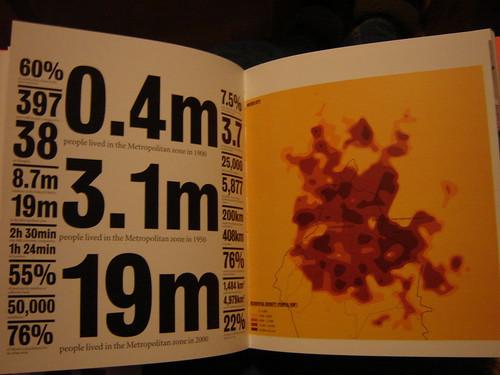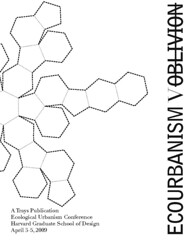One Day to Go
I'm just finishing up all of my prep for the trip tomorrow. I've gotten to spend a good part of the last few days collecting materials and reading. By coincidence, J got me the book The Endless City for x-mas, which has Mexico as one of the 6 cities that it focuses on (along with Berlin, New York, London, Shanghai and Johannesburg). And it's been pretty interesting reading. In fact, it's really challenged my perceptions of some of how cities in the developing world are shaped. 
the mexico city info page from endless city
For a long time, I've been influenced by Manual Castells, who has said that we are moving farther and farther away from actually having developed and developing countries. Rather, throughout the world, we can see a greater tendency towards what might be called "first world" cities surrounded by "third world" peripheries and rural areas. Even in the US, which is often seen as being the "opposite" of the rest of the world in spatial terms (poor cities/rich suburbs rather then rich cities/poor suburbs), I feel that we can see the beginnings of this orientation asserting itself in NY, Boston, and even in LA. I still hold that in general, this is probably true. What I've been realizing, however, is that this has led me to think of peripheral urbanization as the only part of cities in the global south that needs "community development."
In the case of Mexico City, there seems to be two different population trends that are both putting a lot of pressure on the city. The first, as I've commented, is the poorer (and largely informal) development at the edges of the metro area. The second (and one that I'll be coming into more direct contact with on this trip) is the loss of population at the center, in what would still be considered upper middle class areas of the city. So instead of this two tiered system of rich at the center, poor on the outside, Mexico is become more of a three tiered city: poor on the outside, rich in the middle and a hollow center.
From a community development standpoint, I think this leads to a lot of interesting questions. Is an empty center part of the solution for the pressures of urbanization at the outside? is it recolonization by the rich who have been leaving? worker housing? and, of course, what is a politically palatable solution in a city that is simultaneously the eighth richest in the world, but still has more then 30% of it's residents living well below the poverty line?
Anyway, that's some of what I've been thinking about over the last few days. I will be getting into MX late tomorrow night, and on Sunday, my friend from the foundation gave me a bunch of walks that he said would be good to get a feel for the city. I'll probably try to blog again on Sunday night.
First, check out Alex's comment on the last post.
After that, the most directly related book has been Keith Pezzoli's
Human Settlements and Planning for Ecological Sustainability. Keith happens to be a Planners Network guy as well has having been my friend's-girlfriend Melissa's advisor at USC. I've also found a bunch of his articles in Progressive Planning magazine that i'd be willing to spread around.
Some other ones I've liked on Latin American urbanism are:
Mike Davis' Magical Urbanism and Joseph Scarpaci's Plazas and Barrios.
If you are into Anthro, Claudio Lomnitz' Death and the Idea of Mexico is really good.
I'll probably add some links to more articles as time goes on. The next post will be from Mexico City.





0 comments:
Post a Comment